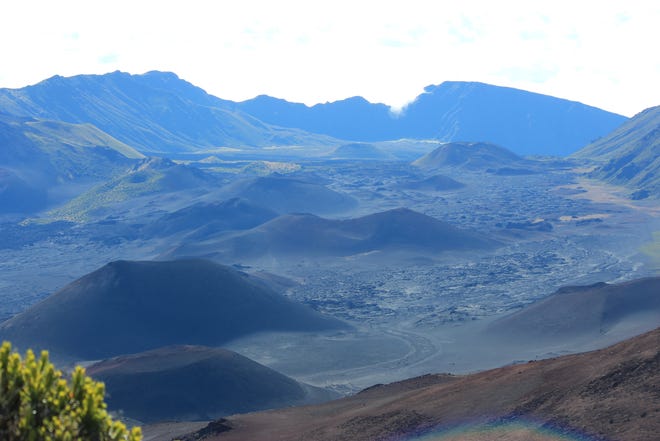
If you’ve ever sung “You’re Welcome” from Disney’s “Moana,” you’ve been singing about a national park – Haleakalā. Its namesake volcano is the very one legend says Maui stood atop to lasso the sun “to stretch your days your days and bring you fun,” as the song goes.
Haleakalā actually means house of the sun in Hawaiian. And people from all over the world travel there to see sunrise from its volcano summit on the island of Maui. But that’s not all there is to see at the park.
“What stands out to me are the colors you see and maybe don’t expect to see,” Jin Prugsawan Harlow, the park’s chief of Interpretation, Education and Volunteers told USA TODAY. “At the summit, you’ll find land shaped by volcanic activity with rich browns, reds, and oranges that make up the Haleakalā Crater. As you make your way to Kīpahulu, you will see lush green forests, deep blues of the ocean surrounded by the black rocky coastline, and rushing white water in the waterfalls.”
Here’s what travelers should know about Haleakalā, the latest national park in USA TODAY’s yearlong series.
Why is Haleakalā so special?

Haleakalā is steeped in Native Hawaiian history and culture.
“Native Hawaiians have lived on and mālama (cared for) the land for over 1,000 years,” according to the park, which notes that various places within the park are included in “Hawaiian mele (songs/chants) and legends.”
“If you are in Kīpahulu, you are visiting a place with rich Hawaiian history as it was used as a village where many people thrived in this fertile land where they grew food, fished, and utilized the freshwater streams found in the area,” explained Harlow. “Kīpahulu was also utilized by other groups of people over the years for sugar plantations, ranching and today, as a national park.”
“The summit of Haleakalā is a wahi pana, a legendary place, and is the wao akua, realm of the gods,” she continued. “It is especially important to Hawaiians for navigation under the exceptionally clear night sky, ceremonies and other traditional practices.”
Harlow urged visitors to respect and help protect these spaces accordingly and stay on trails.
Meet Kala Baybayan Tanaka,a Hawaiian navigator who helped shape Disney’s ‘Moana’
Is Haleakalā still an active volcano? When did Haleakalā last erupt?
Haleakalā is considered a dormant volcano. Its most recent eruption was likely between 1480 and 1600, according to the U.S. Geological Survey, which continues to monitor the volcano for seismic activity.
How long does it take to drive up to Haleakalā National Park?

Haleakalā’s famous summit district is roughly two and a half hours away from Kahului, home of Maui’s main airport, three hours from Wailea and three and a half hours away from Lahaina, which was devastated by wildfires earlier this year.
“It’s a long drive to either district, make sure to fill up your gas tank and to pack a lunch with plenty of snacks as neither are available in park,” Harlow said.
Visitors are urged to take extra care on the steep, winding road to the summit as wildlife try to cross.
“Wildlife on the roadways you may encounter are ʻuaʻu, the Hawaiian petrel, who are difficult to see at night, especially for those coming up for sunrise or down after sunset,” Harlow said. “During the day, you may encounter nēnē, the Hawaiian goose which is a threatened species.”
How long should I stay in Haleakalā National Park?
At least half a day is required to fully experience the park, which is divided into two districts: the Summit District and the Kīpahulu District. Harlow said both popular and three hours apart by car.
To maximize time, she encourages visitors to purchase park passes online in advance. Entrance fees cost $30 per private vehicle, $25 for motorcycles and $15 for visitors entering without a car.
Visitors hoping to catch Haleakalā’s famous sunrise will also need a summit sunrise reservation, which costs $1 per vehicle. Sunsets are also popular, but reservations are not required for viewing those from the summit.

What else should visitors not miss at Haleakalā?
“At the summit, make sure to stop at Hosmer Grove to look for an opportunity to spot extremely rare forest birds known as Hawaiian Honeycreepers,” advised Harlow. “Honeycreepers were once found all across the island but their populations are rapidly declining and for some, extinction may happen in the next few years. High elevation forests like Hosmer Grove are Honeycreepers’ last remaining safe haven from mosquitoes carrying avian malaria.”
“I find at Hosmer Grove, I almost always see an ʻiʻiwi, which is a brilliant scarlet color with black wings and black tail,” she continued. “ʻIʻiwi also have a bright orange and long curve-shaped beak perfectly shaped for feeding on nectar from flowering plants in the area. They have a unique call too, (which) a colleague of mine referred to the call as a ‘rusty robot’ call … it’s actually quite beautiful to hear them.”
What more should visitors know about Haleakalā?
“Most people are caught off guard on how cold it can be at the summit. Jackets and warm layers for strong winds and temperatures below freezing are musts,” Harlow said. “For the Kīpahulu, bring closed-toed hiking shoes for hiking in the slippery and muddy conditions. Make sure to have sun protection like hats, sunglasses, sun shirts, and sunscreen for both locations.”
Hikers are also encouraged to bring maps and share plans with someone who can expect them to check in, as cell service can drop out. Additional tips can be found on Haleakalā National Park’s website.
